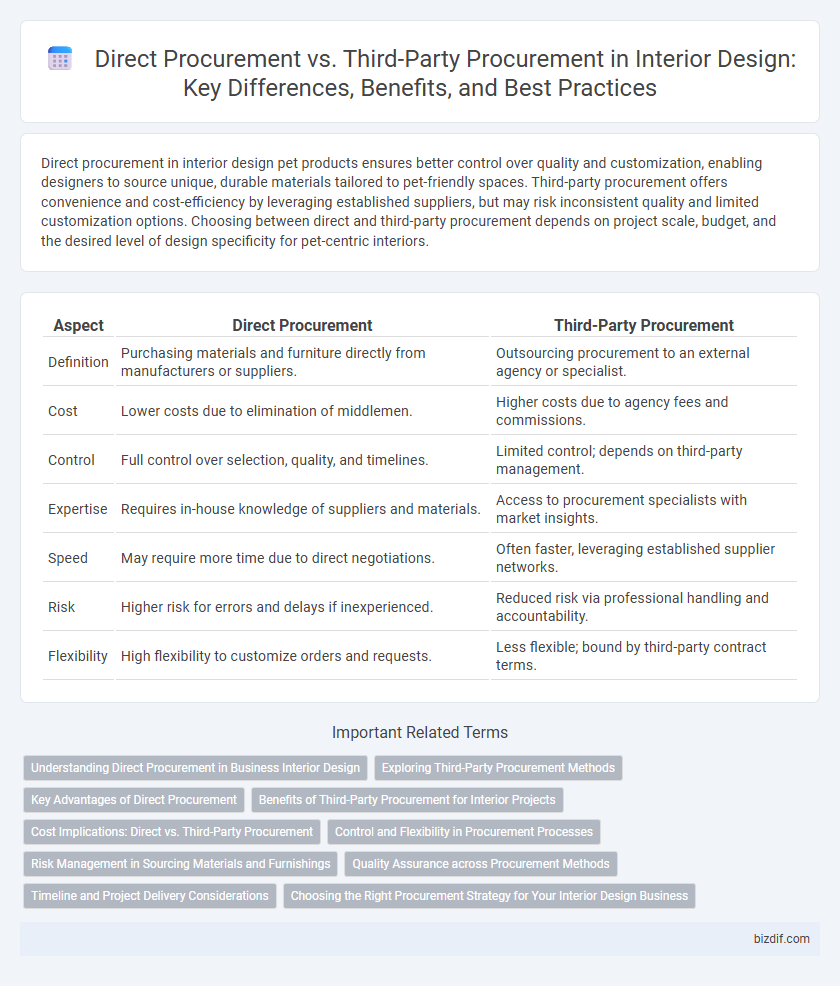Direct procurement in interior design pet products ensures better control over quality and customization, enabling designers to source unique, durable materials tailored to pet-friendly spaces. Third-party procurement offers convenience and cost-efficiency by leveraging established suppliers, but may risk inconsistent quality and limited customization options. Choosing between direct and third-party procurement depends on project scale, budget, and the desired level of design specificity for pet-centric interiors.
Table of Comparison
| Aspect | Direct Procurement | Third-Party Procurement |
|---|---|---|
| Definition | Purchasing materials and furniture directly from manufacturers or suppliers. | Outsourcing procurement to an external agency or specialist. |
| Cost | Lower costs due to elimination of middlemen. | Higher costs due to agency fees and commissions. |
| Control | Full control over selection, quality, and timelines. | Limited control; depends on third-party management. |
| Expertise | Requires in-house knowledge of suppliers and materials. | Access to procurement specialists with market insights. |
| Speed | May require more time due to direct negotiations. | Often faster, leveraging established supplier networks. |
| Risk | Higher risk for errors and delays if inexperienced. | Reduced risk via professional handling and accountability. |
| Flexibility | High flexibility to customize orders and requests. | Less flexible; bound by third-party contract terms. |
Understanding Direct Procurement in Business Interior Design
Direct procurement in business interior design involves sourcing materials and furnishings straight from manufacturers or authorized suppliers, ensuring control over quality and customization. This approach often reduces costs by eliminating third-party markups and accelerates project timelines through direct communication channels. Understanding direct procurement allows interior designers to secure exclusive products and maintain consistency in design aesthetics across commercial spaces.
Exploring Third-Party Procurement Methods
Exploring third-party procurement methods in interior design involves outsourcing material sourcing and vendor management to specialized agencies, ensuring access to a broader network of suppliers and competitive pricing. These methods streamline project timelines by leveraging third-party expertise in quality control, logistics, and compliance with design specifications. Utilizing third-party procurement reduces operational risks, enhances cost efficiency, and allows interior designers to focus on creative execution rather than supply chain complexities.
Key Advantages of Direct Procurement
Direct procurement in interior design ensures tighter control over material quality and project timelines by sourcing directly from manufacturers and suppliers. This approach reduces intermediary costs, resulting in significant budget savings and increased transparency throughout the supply chain. Enhanced customization options and faster delivery times also make direct procurement a preferred strategy for high-end and bespoke interior design projects.
Benefits of Third-Party Procurement for Interior Projects
Third-party procurement in interior design projects offers access to a wider range of specialized suppliers and materials, often resulting in cost savings and higher quality products. It reduces the administrative burden on design firms, allowing them to focus more on creativity and project management. Enhanced scalability and flexible sourcing options improve project timelines and overall efficiency.
Cost Implications: Direct vs. Third-Party Procurement
Direct procurement in interior design often reduces costs by eliminating middlemen, allowing for bulk purchasing and direct negotiation with manufacturers. Third-party procurement may introduce additional fees and markups, increasing overall expenses but providing access to specialized suppliers and streamlined logistics. Carefully evaluating project scale and complexity helps determine which procurement method optimizes budget efficiency.
Control and Flexibility in Procurement Processes
Direct procurement in interior design offers greater control and flexibility by enabling designers to source materials and furnishings directly from manufacturers, ensuring quality standards and customization options are met precisely. Third-party procurement, while potentially simplifying logistics, often reduces the ability to tailor purchases and respond swiftly to design changes due to reliance on intermediaries. Maximizing control over supplier selection and timelines is critical in maintaining project integrity and achieving unique design outcomes.
Risk Management in Sourcing Materials and Furnishings
Direct procurement in interior design allows for greater control over material quality and supplier reliability, significantly reducing risks related to counterfeit or substandard furnishings. Third-party procurement introduces dependency on intermediaries, increasing the potential for miscommunication, delays, and variability in sourcing critical elements like custom fabrics or artisanal decor. Effective risk management involves strict supplier vetting, transparent contracts, and ongoing quality audits to ensure timely delivery and adherence to design specifications.
Quality Assurance across Procurement Methods
Direct procurement in interior design ensures stringent quality control by allowing designers to source materials and furnishings directly from manufacturers, reducing the risk of defects and enabling closer inspection. Third-party procurement relies on intermediaries who may offer a broader range but can introduce variability in quality due to less direct oversight. Implementing robust quality assurance protocols is crucial regardless of the procurement method to maintain design standards and client satisfaction.
Timeline and Project Delivery Considerations
Direct procurement in interior design enables faster project delivery by streamlining supplier communication and reducing lead times through direct orders, which is critical for time-sensitive renovations. Third-party procurement, while potentially slower due to additional coordination layers, offers advantages in managing complex supply chains and mitigating risks associated with delays. Project timelines must consider these factors, balancing direct procurement's speed against third-party procurement's comprehensive oversight to meet critical delivery deadlines efficiently.
Choosing the Right Procurement Strategy for Your Interior Design Business
Direct procurement in interior design enables businesses to source materials and furnishings straight from manufacturers, ensuring cost-efficiency and greater control over quality and customization. Third-party procurement involves using external agents or firms to handle purchasing, which can save time and leverage supplier relationships but may increase overall costs. Interior design businesses should assess project scale, budget flexibility, and supply chain complexity to select the procurement strategy that maximizes value and operational efficiency.
Direct procurement vs Third-party procurement Infographic

 bizdif.com
bizdif.com